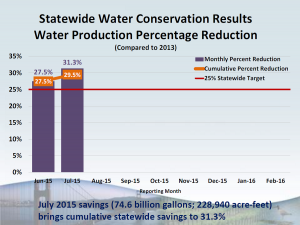Despite one of the hottest summers on record, California’s investor-owned water utilities (IOUs) continued to lead the way as water agencies statewide responded to the drought and mandated water reductions. On August 27, 2015, the State Water Resources Control Board (State Water Board) released statewide water conservation results for July, indicating an overall 31.3 percent drop in urban water usage, comfortably exceeding Governor Brown’s 25 percent reduction mandate. Combined with the June statewide reduction of 27.3 percent, the cumulative statewide savings was 29.5 percent, a welcome outcome for state officials, given that saving water in the hottest months is critical to meeting the reduction mandate.
According to a recent State Water Board news release, “The amount of water saved in July 2015 (74.6 billion gallons) is more than four times the amount of water saved in July 2014 (18 billion gallons), when the State’s voluntary 20 percent conservation goal was in effect.”
IOUs constitute 60 of the 411 reporting retail water districts or customer service areas in the state, and in both June and July, 50 met or exceeded their state-mandated conservation targets. Further, 35 of the IOU districts met or exceeded the state average reduction of 31.3 percent; 23 exceeded 35 percent, and seven exceeded the 40 percent savings threshold. San Gabriel Valley Water Co., California American Water’s Sacramento and San Diego Districts, California Water Service’s (Cal Water) Livermore and Redwood Valley Districts and Del Oro Water Company’s Paradise Pines District were recognized at an August State Water Board presentation as having achieved noteworthy conservation efforts exceeding mandates by 20 percent.
Additionally, the State Water Board’s press releases recognized several CWA member companies for their conservation performance. “Dozens of communities achieved conservation levels of more than 30 percent in June 2015,” including California Water Service’s Antelope Valley (High Desert). “Suppliers demonstrating remarkable performance included: San Gabriel Valley Water Company reduced water use by 35 percent in June, 1.5 times greater than the 23 percent reduction recorded in May. San Gabriel Valley’s Stage 2 drought restrictions and penalties were approved by the California Public Utilities Commission on June 22, 2015. Santa Clara Valley Water District set a 30 percent savings goal for its service area in March 2015, and nine of its 11 urban water suppliers, including the San Jose Water Company and the City of San Jose, exceeded the 30 percent goal in June, leading to an overall savings rate of 35 percent for the District.”
Despite the governor’s and regulatory agencies’ drive to reduce water consumption in California, they also recognize the need to balance conservation with business operations that are highly dependent on water. Cal Water’s Dominguez system is one such example with several critical businesses that cannot further reduce water consumption to achieve the mandated levels without impacting their core businesses. In an effort to comply with the State’s mandate in districts that include these types of businesses, Cal Water developed an alternative means of complying with the water budgets established for its customers who are both “industrial water users” and have fixed or firm “process water” requirements. These customers may propose an alternative allocation of water budgets for non-process/incidental water use between different service connections by completing an application and complying with specific reporting requirements. Additionally, after months of discussion with the State Water Resources Control Board, the Board recently issued an alternate compliance order for Cal Water’s Dominguez system that took into account the fact that the system could not meet the reduction requirement due to customers’ process water needs.
All of the IOUs have invested in outreach and education programs to encourage their customers to conserve water. The June and July enforcement data highlight the success of those communication efforts.






